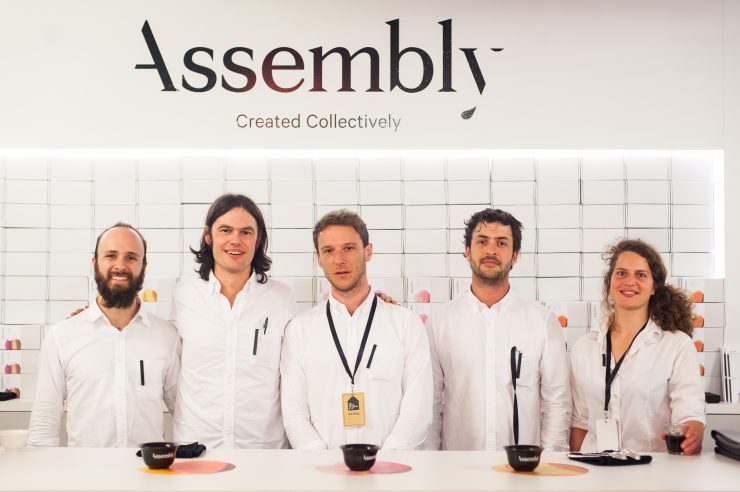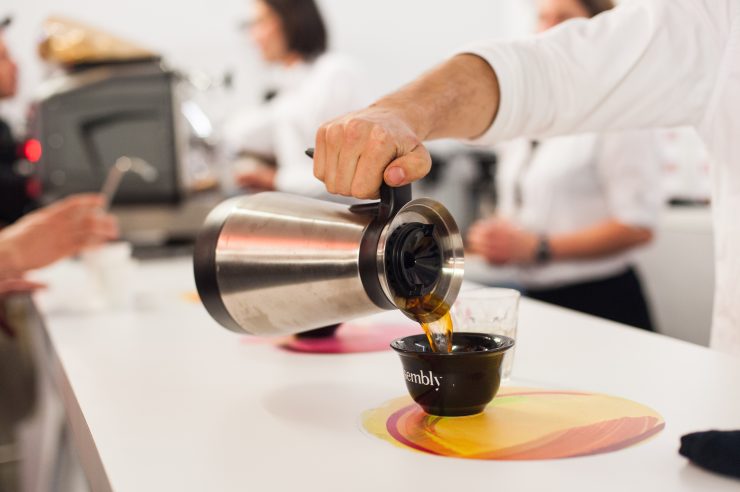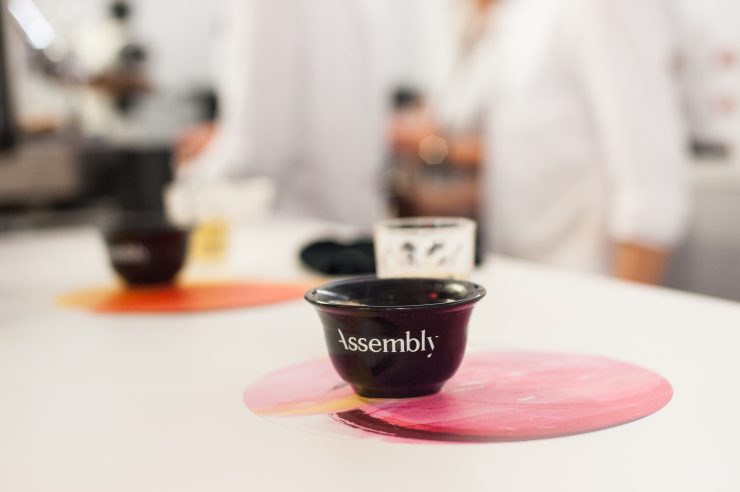Keen coffee connoisseurs in London may have noticed a new roastery on the shelves of some of London’s finest small cafes. Housed in pristine white boxes rather than bags, with only a name and not much else on the outside, Assembly‘s launch began with a whisper. First a bit of social media buzz, circling around a launch at the London Coffee Festival, and then hints at the collaborators involved. It’s a lineup of names worth sitting up to take note of. Many of them belong to smaller, well-respected businesses in London along with some bigger players: Story Coffee, Esters, CREAM, Embassy East, Noble Espresso, The Wash, Three Wheels Coffee, Soho Coffee House, and DunneFrankowski.
Opening whispers aside, Assembly didn’t just appear out of thin air. There were months of planning and a lot of research that went into the beginning of this company, which is technically a sub-brand of the already extant Volcano Coffee Works based in South London. Speaking with one of the founders of Assembly, Michael Cleland, earlier this year at the Embassy East cafe, I received a little bit of insight into the ethos and impetus behind the creation of the new brand.
Volcano Coffee Works faced a problem that many specialty coffee roasters of a certain size seem to face: if some of their clients were restaurants, and some of their clients were independent cafes, how were they to cater to two almost completely different markets? Volcano has focused heavily on London’s restaurant market, but wanted to get involved more with independent cafes in a way that would set them apart from other roasters in London. There are a lot of them, after all, many doing what they do very well indeed, and for Volcano to offer something new would be difficult.
The research that followed focused on finding those unfulfilled needs that independent cafes had that they could be the first to meet. Eventually, this allowed Volcano to stop straddling two segments of the market and focus only on sourcing and roasting coffees for restaurants, while the sub-brand Assembly was created to answer to the needs of independent cafes.
“Restaurants and cafes have very different needs,” Cleland explains. He should know—even though he now works for Mission, a well-regarded restaurant in London that cares very much about its coffee, he has spent time behind the bar in some of London’s best coffee shops like Notes and Sharp’s. “The concept for Assembly is about finding the needs of indie cafes and committing to fulfill those needs… evolving when those needs inevitably evolve. This is a super dynamic, super fast-paced, super progressive industry. What is valuable to cafes today might not be valuable to cafes tomorrow.”
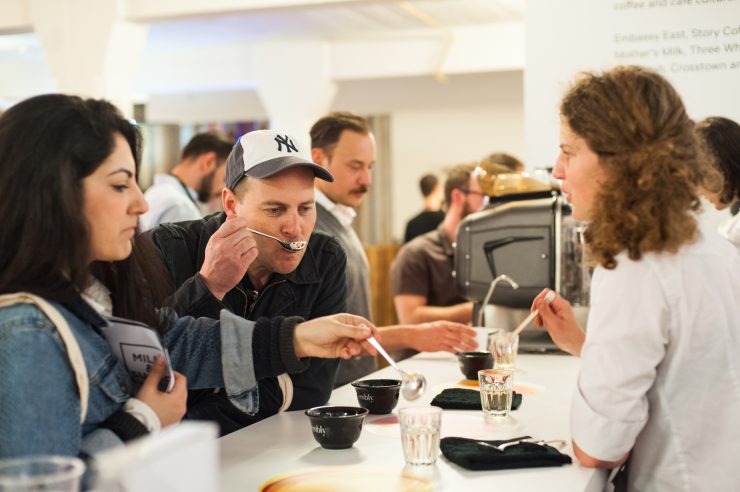
This is where the “assembly” concept comes into play. All of the cafes, baristas, roasters, and coffee consultants involved with the company both solicit and offer feedback about the coffee that Assembly is roasting, as well as providing general feedback about cafe work and cafe life. The important bit, says Cleland, is that the relationship between roaster and cafe is viewed less as a wholesale partnership and more as a relationship where everybody plays an equal part.
“It’s about the whole being greater than the sum of the parts and collaborating for a common cause, which is to innovate and move independent coffee forward,” he says with an emphatic nod.
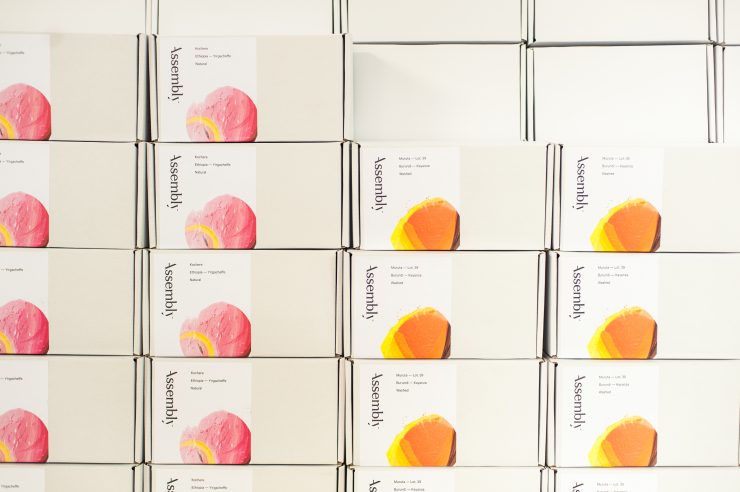
One example of innovation from this hive mind sort of framework is immediately clear upon looking at Assembly Coffee’s packaging. Minimalist and eye-catching, most boxes are plain white, except for a motif that is a bold splash of blended colors, like watercolor brush strokes. Upon closer inspection, you’ll find the box has at least a blend name, variety name, and country of origin written on it, but they’ve chosen to eschew tasting notes completely and go for a much more conceptual representation of their coffees. The bright spot graphic included on the packages, unique to each coffee, is meant to visually communicate the sense of the coffee to the customer—whether it is well-rounded and mellow, whether it might have more acidic flavors of fruits, or smooth caramels and chocolates.
Public trials of this new packaging concept, like their exhibition at the London Coffee Festival, have yielded interesting data. A trend emerged: coffees that appealed to the customers visually were often the coffees they actually liked the taste of most. It intrigues Cleland and the other Assembly co-founders to think about the possibilities therein. An open environment like this one is prone to biases and influencer cues, but it seems on the surface that this could very well be a new way of effectively communicating to customers the characteristics of a coffee. By choosing to forego tasting notes on the packaging, Assembly have done away with the limits of written language; a more visual approach to tasting notes opens up new possibilities for communication.
Trying to figure out what’s needed and what’s wanted next in the ever-changing specialty coffee scene is no easy task. No brand is an island, but when it comes to collaboration, the team at Assembly have gone all in, and where the project goes next is a matter of shared destiny.
Kate Beard (@SBinLondon) is a Sprudge staff writer based in London. Read more Kate Beard on Sprudge.
The post At Assembly London, A Collective Of Coffee Brands Come Together appeared first on Sprudge.


